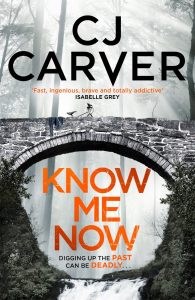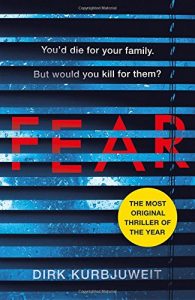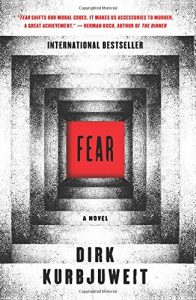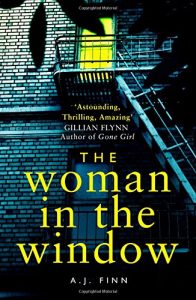Published by Simon & Schuster
Know Me Now by C. J. Carver
Published by Zaffre
Killer Intent by Tony Kent
Published by Elliott & Thompson
Fear by Dirk Kurbjuweit
Published by Orion UK/Harper US
The Woman in the Window by A.J. Finn
Published by HC UK/William Morros US
The New Year brings an enormous range of excellent crime fiction. Among the most interesting is Kate Rhodes’s Hell Bay. With all the traditional virtues of a murder investigation within a closed community and set against a vividly rendered landscape, it features Detective Inspector Ben Kitto. He is returning to Bryer, the smallest of the inhabited Scilly Isles, after many years. Like all the other teenagers then and now, he longed for a world bigger and more exciting than the Scillies and found both working under cover for the Metropolitan Police. Now on extended leave, he finds a murder has been committed on the island, where there is so little reported crime that the inhabitants leave all their doors open. Human beings are never as straightforward as they seem and crimes of many kinds have been going on behind the scenes. The local police chief grudgingly accepts Ben’s offer to lead the murder investigation and he fights his tribal loyalties, uses his long experience in the Met, and picks his way between the angers and the jealousies that occasionally make every individual islander seem capable of killing. Without graphic violence or melodrama, this is a quietly intelligent novel with convincing psychological  insights and enough human warmth and optimism to carry the more miserable aspects of the characters’ lives.
insights and enough human warmth and optimism to carry the more miserable aspects of the characters’ lives.
C.J. Carver also links past and present in an isolated community damaged by frightening secrets, in this case in the north of Scotland. Know Me Now opens with the death of a troubled boy and involves his father and a group of people who have been his friends since childhood. Their youthful secrets and misdemeanours are revealed in flashbacks as they try to help the community deal with Connor’s death. The new doctor is certain he didn’t kill himself and insists on a proper investigation in the teeth of the local authorities’ stubborn insistence that there’s no need for even so much as a blood test.
Much worse is to come as the novel moves to Germany. Dan Forrester, one of the original group, is trying to find out the truth about his elderly father’s death. The two investigations merge as the  original group struggle to make their adult lives work. One wonderful scene involves Dan desperate to get home to the UK in time for the birth of his latest child, frustrated by weather, road accidents, and official obstruction. Dealing with issues that are important to all of us, filled with agreeable characters pushed to their limits, and tense with dramatic moments, this is a terrific thriller.
original group struggle to make their adult lives work. One wonderful scene involves Dan desperate to get home to the UK in time for the birth of his latest child, frustrated by weather, road accidents, and official obstruction. Dealing with issues that are important to all of us, filled with agreeable characters pushed to their limits, and tense with dramatic moments, this is a terrific thriller.
Tony Kent’s first novel, Killer Intent, is another exciting thriller and includes more hand-to-hand fighting than I’ve read for a long time. Kent, a barrister, is also a boxer and therefore must know what he’s writing about, but his characters’ ability to get up and have another go after being whacked and walloped seems superhuman. His hero, Michael Devlin, is also a barrister but rather an unusual one. He becomes involved in a convoluted assassination plot after a telephone call from the solicitor called to represent a man who’s killed the UK’s most popular politician. If  your taste runs to action thrillers packed with conspiracies and plenty of information, this is the novel to cheer your dark winter days.
your taste runs to action thrillers packed with conspiracies and plenty of information, this is the novel to cheer your dark winter days.
More cerebral pleasures are to be found in Dirk Kurbjuweit’s Fear. Randolph, a Berlin architect, is the first-person narrator of this intelligent and disturbing novel. The flat in which he lives with his wife and children is just above a basement inhabited by a single man on benefit, who not only stalks the wife and leaves creepily threatening letters and poems for her but also accuses both husband and wife of sexually abusing their children. The narrator’s internal struggles are  even more absorbing than his external ones. The threat makes him revisit his own difficult childhood, which was ruled by his angry father’s passion for guns. Not only did the older man teach all his children to shoot, he also carried a gun wherever he went, terrifying Randolph with the possibility that he would shoot one of his family or even some stranger who annoyed him.
even more absorbing than his external ones. The threat makes him revisit his own difficult childhood, which was ruled by his angry father’s passion for guns. Not only did the older man teach all his children to shoot, he also carried a gun wherever he went, terrifying Randolph with the possibility that he would shoot one of his family or even some stranger who annoyed him.
Fretted by his inability to protect his family from the stalker, Randolph also worries about the state of his marriage and his relationships with his parents and his siblings. Is he weak or constrained by conscience? Is he selfish or normal? Might his wife, in fact, have abused the children? How responsible is he for everything around him? These question and others torment him and mirror the state of any rational person trying to negotiate the inevitable difficulties of building and maintaining a happy life with other people who have different fears and needs and longings.
This is the first of Kurbjuweit’s seven novels to be published in English and it offers an excellent example of the literary psychological thriller.
A.J. Finn’s The Woman in the Window is a clever and engaging take on the highly fashionable is-she-mad-or-is-she-a-victim? puzzle. Anna Fox is agoraphobic, drinks far too much, misuses her prescription medication, watches and rewatches her favourite black-and-white movies, dreams of her absent husband and daughter and spies on her  neighbours. The novel is a homage to Rear Window and covers some similar ground to The Girl on the Train, although Anna is far more intelligent and appealing than Rachel Watson. Watching her latest neighbours, Anna is sure she sees a woman stabbed to death and braves the world outside her apartment to get help. Disasters and revelations of her past and present follow in an engrossing examination of a mind under threat from itself and a body that may or may not be the target of a psychopath.
neighbours. The novel is a homage to Rear Window and covers some similar ground to The Girl on the Train, although Anna is far more intelligent and appealing than Rachel Watson. Watching her latest neighbours, Anna is sure she sees a woman stabbed to death and braves the world outside her apartment to get help. Disasters and revelations of her past and present follow in an engrossing examination of a mind under threat from itself and a body that may or may not be the target of a psychopath.

